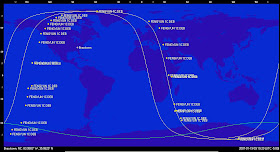
The Chinese, on January 11, successfully launched an anti-satellite missile which rammed and destroyed one of their old sun-synchronous orbit weather satellites - Fengyun 1C (1999-025A/25730). At the time of its destruction Fengyun 1C was in a 875 x 867 km orbit (102.38 minute period) inclined 98.59 degrees. This satellite was launched on May 10, 1999.
As of this writing NORAD has officially cataloged 32 objects (1999-025E to 1999-025AM/29716 to 29747) that now pollute a vital area of space (sun-synchronous polar orbit). There are over 125 satellites that operate in this portion of space. At the top of this page I have posted a plot of the 32 objects as seen around 1400 UTC. As you can see from the plot the objects are pretty much scattered over the entire orbit of the old Fengyun 1C.
An Aviation Week and Space Technology article, which first reported the test, stated that the Fengyun 1C satellite, "was attacked by an ASAT (anti-satellite) system launched from or near the Xichang Space Center." This event was the first successful test of the missile after three failures.
According to the AWST article, a government official said that U.S. "space tracking sensors" confirmed that the satellite is no longer in orbit and that the collision produced "hundreds of pieces of debris," that also are being tracked. As we mentioned above, NORAD has only catalogued 32 of the objects so far.
As of this writing NORAD has officially cataloged 32 objects (1999-025E to 1999-025AM/29716 to 29747) that now pollute a vital area of space (sun-synchronous polar orbit). There are over 125 satellites that operate in this portion of space. At the top of this page I have posted a plot of the 32 objects as seen around 1400 UTC. As you can see from the plot the objects are pretty much scattered over the entire orbit of the old Fengyun 1C.
An Aviation Week and Space Technology article, which first reported the test, stated that the Fengyun 1C satellite, "was attacked by an ASAT (anti-satellite) system launched from or near the Xichang Space Center." This event was the first successful test of the missile after three failures.
According to the AWST article, a government official said that U.S. "space tracking sensors" confirmed that the satellite is no longer in orbit and that the collision produced "hundreds of pieces of debris," that also are being tracked. As we mentioned above, NORAD has only catalogued 32 of the objects so far.
This is an immediate theat to anything in low earth orbit (900 km and below). This includes our low earth orbit military imaging satellites (Lacrosse/KH-12) and military weather satellites (DMSP). There is no indication based on this first successful ASAT mission that the Chinese can threaten other vital constellation of satellites such as our GPS navigation satellites or military communication platforms, which are in a much higher orbits. But we will have to see further test of this system to determine the full capability of this Chinese ASAT system.